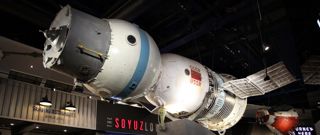
The Soyuz 11 Disaster
- 30th May 2018
- Author: Dan Kendall
June marks the anniversary of one of the most tragic missions in space history – Soyuz 11.
Georgy Dobrovolsky, Vladislav Volkov, and Viktor Patsayev launched from the Baikonur Cosmodrome on 6 June 1971 in their Soyuz 7K-OKS spacecraft. The mission set a new record for the longest time spent in space, as they travelled to the first ever space station – Salyut 1.
Tragically, the crew would also become the first people to die in space.
Dobrovolsky, Volkov, and Patsayev clocked an impressive 23 days in orbit. Under the command of Dobrovolsky, they put the Salyut 1 space station through its paces. It was a big moment for the Soviet space programme. America had landed on the Moon two years earlier – Russia hoped that Salyut would help them to recapture some of the earlier dominance they had enjoyed in space exploration.
The crew spent 22 days aboard the station, enjoying an unprecedented amount of room to move – compared to the cramped spaces within the Soyuz spacecraft. They were able to exercise using a treadmill and carry out experiments on the effect of longer duration spaceflight to the human body.
The crew became household names in their homeland, thanks in part to having their own slot on Moscow television – broadcasting live from space.
Their stay aboard Salyut was cut short though, having experienced problems with the space station – including an electrical fire. Dobrovolsky, Volkov, and Patsayev re-entered their Soyuz spacecraft on 29 June, undocked from Salyut, and began their descent back to Earth.
The return to Earth seemed normal, although communications with the crew had been lost. As recovery teams arrived at the landing site in modern-day Kazakhstan, the Soyuz descent module appeared to have landed safely despite having rolled onto its side. Knocking on the side of the spacecraft received no response. Shortly afterwards, having opened the hatch, recovery workers were horrified to find all three crew members dead.
Back in mission control, they awaited news from the recovery team. They were met with the devasting code, ‘1-1-1’. When cosmonauts returned to Earth, recovery teams always indicated their health using a number code. ‘5’ indicated excellent health, whilst descending numbers indicated that the cosmonauts were injured. This secret code used ‘1’ to let officials know of fatalities.
Slowly, news got out of the tragedy. This issue of Time Magazine (pictured) featured the tragic events long before the Soviet Union explained the cause of death. Rising above Cold War tensions, the magazine focused on the shared sense of loss caused by the deaths.
President Richard Nixon issued an official statement, expressing US sympathies, whilst astronaut Tom Stafford acted as a pallbearer as the crew received a state funeral and were buried in the Kremlin Wall Necropolis at Red Square, Moscow. Cold War tensions were beginning to break down, as the two superpowers ushered in a new age of collaboration in space.
In the aftermath of the Soyuz 11 disaster, thoughts turned to the investigation and the cause of death. All three crew members had died from suffocation, with the rescue teams having had no chance of saving them.
The issue that had caused the crew to suffocate was traced back to a faulty breathing ventilation valve, which had exposed the crew to the vacuum of space. Shortly before returning to Earth, as the Soyuz descent module decoupled from the orbital module, the valve had come open too early – depressurising the spacecraft. With oxygen escaping out into space, the crew quickly ran out of air, suffocating before they could close the valve.
Dobrovolsky, Volkov, and Patsayev remain the only humans to have died in space. Others have been lost in the name of space exploration, on the launch pad, or during re-entry, but the Soyuz 11 crew are the only people to have been exposed to the extreme environment of space directly. Sadly, if they had been wearing spacesuits, they would have survived.
It was quickly apparent to the State Commission, chaired by Mstislav Keldysh, that the choice to stop wearing spacesuits had been a mistake in the early Soviet space programme. Development began quickly on the Sokol-K spacesuit – a special high-altitude pressure suit to be worn inside Soyuz spacecraft, providing pressure and air supply to cosmonauts in case of emergency.
These days, when travelling inside Soyuz, cosmonauts wear a modified Sokol KV-2 suit. Helen Sharman‘s Sokol KV-2 suit, which she wore during training for her spaceflight in 1991, is displayed in our Into Space gallery. Every time I see it, I am reminded of the difference such a suit would have made to Georgy Dobrovolsky, Vladislav Volkov, and Viktor Patsayev.
The National Space Centre pays tribute to the brave crew of Soyuz 11 and all the other pioneers who have been lost in the effort to explore space. Every June we remember their sacrifice and bravery, as we salute true heroes of space exploration.
About the author: Dan Kendall is the Curator at the National Space Centre.










